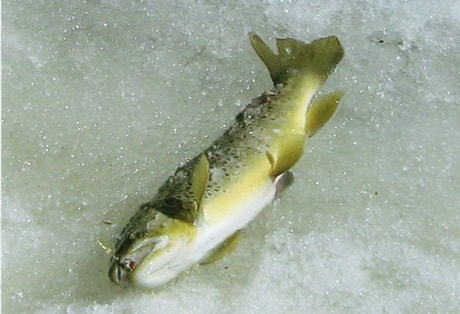More Alberta anglers than usual are choosing the off-shore option to open their fishing season as, here at home, we are experiencing yet another slow, cold spring. They delight in emailing me pictures of themselves in tropical scrubs or shorts holding their catches: bonefish, snook and jack crevalle.
I’ve taken the easy way out occasionally myself: spring trips to Belize, Cuba, England, Italy and, most recently, France. But this year a long-scheduled surgery made going off-shore not an option. It was bad enough that I knew of some open water where fishing was possible, if only my ultra-light spinning rig was not snowed-in, but those tropical pictures pushed me over the edge.
The breeze from the west on the sunny Sunday before our medical trip to Calgary seemed to be sending me a message, a siren song that the time was ripe out there. So I searched the room where I store all outdoors and surfaced with my old Mitchell 304 spinning reel and my Dad’s last spinning rod, a long Garcia light action. Miraculously, the box of small spinning lures was also there, rather than snowed in at the Stump Ranch with that ultra-light outfit.
The solemn promise to Herself was that it was three hours, max, to get there, make no more than a dozen casts, then drive back home. Why does an inveterate fly fisherman need a spinning outfit? All the reasons are once again obvious when I arrive at the spot. Wading is impossible most of the time, let alone with the tilting shelf of ice on both banks, and the quarters are generally too tight for fly casting, let alone with the howling wind.
Besides, some things are sacred: before I had really started fly fishing, I caught the first two brown trout I had ever seen on a spinning outfit exactly here in late March of 1963. In that box of tiny lures I found the last two of my Mepps #0 gold spinners with the red tube around the treble hook shank, the lure that took those first two browns.
Recently I was in a Canadian Tire and concluded that Mepps is probably no longer making that model. As I searched the entire lure wall in vain for an acceptable substitute, I gritted my teeth at the nearly $5 each these tiny lures now cost and approached rage that the treble hooks on virtually all of them had barbs.
Out there on the ice shelf, as I laboriously pinched the barbs down on the treble hook of each of those last two #0 Mepps golds, I mused that they cost about $2 each when I bought them back when the useless mandatory barbless regulation had not yet even been dreamed of. It is rank discrimination to make the angler part of the manufacturing process: if you make it mandatory to use barbless hooks in Alberta, then make it illegal to sell barbed hooks in Alberta.
The first several casts were disasters. The old line on the reel had more memory than my computer and that, combined with the wind, was building bird’s nests of tangled monofilament in the sky. Eventually we got it straightened out and stretched so that I was able to cast the Mepps several times onto the ice shelf opposite and pull it off precisely into the sweet spot of yore.
But nothing happened; could it be, perhaps, too bright over there? I have a theory, bolstered by scientific papers I have read over the years on the subject of the vision of various species of fish, that stream brown trout are extremely sensitive to the sudden bright light after a long, dark winter under the ice.
When the ice goes out, they hide in the shade under the ice shelves clinging to the banks and can occasionally be lured out if the sun is not too bright on the open water.
There was a distinct line just downstream between glaring water and dark water shaded by high banks and tall spruce trees, so I fired my longest cast of the day, and what I calculate was the 11th, far down into the dark and right beside the ice shelf on the opposite bank.
After 60 years of going fishing too early I have concluded that most species, in very cold water, prefer a lure that is moving very slowly. So I retrieved the lure, against the current just fast enough to keep it from snagging the bottom and to keep the spinner blade rotating.
When it was halfway in I thought I had failed and snagged the bottom, because I did not see a fishy flash down there.
But the “bottom” moved and eventually I slid a 56-cm brown trout up onto the ice shelf on my side. Rejoice: season’s also open up here in the un-tropics!
Bob Scammell is an award-winning outdoors writer living in Red Deer.
